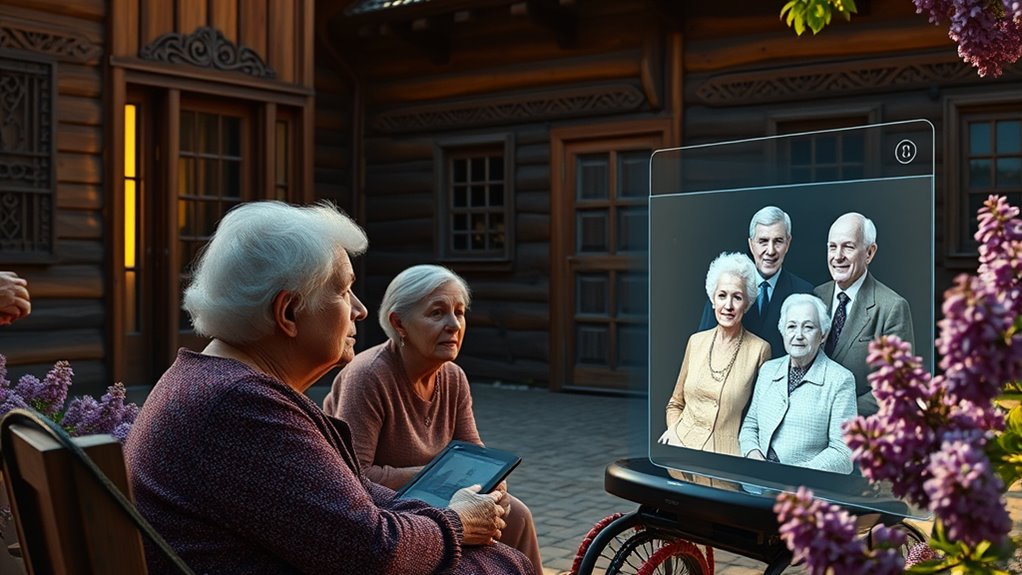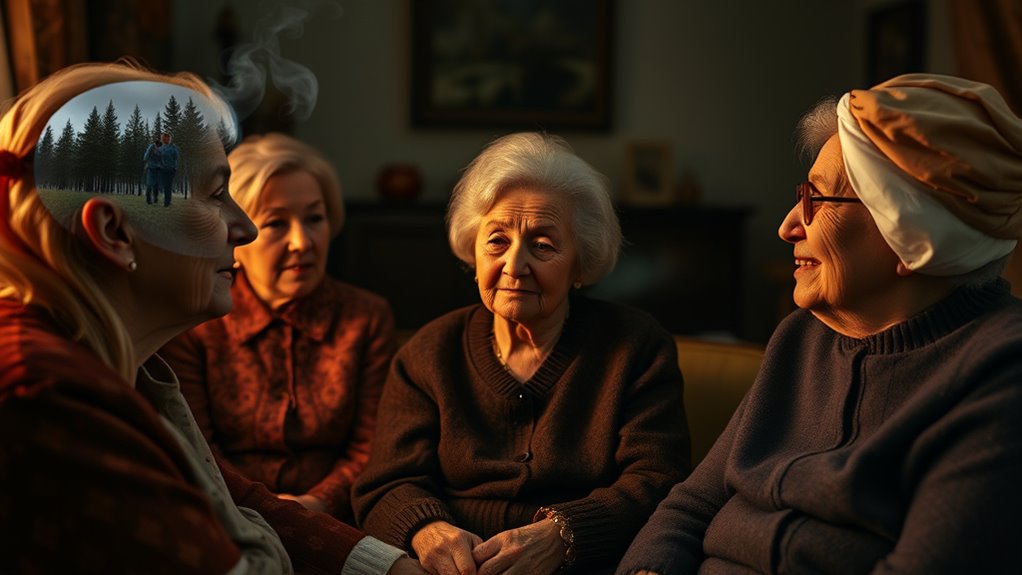Russian widows are turning to AI technology to reconnect with their deceased husbands through personalized digital memories. They use AI-generated videos, voiceovers, and interactive representations to create virtual farewells, reunions, or lasting memories. These tools help them find comfort, maintain emotional bonds, and cope with loss. As these digital rituals become more common, new ways of mourning emerge. If you want to explore how these innovations are shaping grief, there’s more to uncover ahead.
Key Takeaways
- AI platforms like “Living Memory” create personalized digital reconstructions of deceased husbands based on stories and recordings.
- Widows use AI-generated videos and voiceovers to reconnect emotionally and preserve their loved ones’ memories.
- These tools offer virtual farewells, reunions, and ongoing presence, helping widows cope with loss.
- Consent and authenticity are ethical considerations when creating and sharing AI reconstructions of the deceased.
- Such AI memories influence mourning practices, providing comfort while raising questions about dependency and memory authenticity.

In a time when grief can feel overwhelming, Russian widows are turning to cutting-edge AI technology to reconnect with their lost husbands. One prominent service, “Final Meeting,” creates AI-generated farewell videos of soldiers killed in the Ukraine war. These videos show soldiers embracing loved ones, walking up stairs to heaven, transforming into birds, or disappearing into the distance. The process offers a way for widows to say goodbye in a deeply personal manner. Prices range from about 1,500 to 3,500 rubles ($18.50 to $43), with options to add voiceovers that use the deceased’s “real voice” for an even more authentic feel. Due to high demand, most requests are placed on waiting lists, and expedited services cost more.
Most widows request highly personal projects—farewells, virtual reunions, or moments to reconnect with their loved ones’ memories. These AI-generated videos serve as modern rituals of mourning, helping women cope with loss by creating a sense of ongoing presence. Behind the scenes, technologies like “Living Memory” build interactive representations of the deceased based on their stories, personality, and wisdom. These systems allow users to ask questions, hear their loved ones’ perspectives, and keep their memory alive. This innovation explores ethical challenges, such as the authenticity of these representations and the consent involved, but it also offers a way to preserve personalities beyond physical death. The technology can even analyze voice recordings to produce a more realistic and personalized voiceover, enhancing the emotional impact. These developments demonstrate how AI is transforming traditional mourning practices and offering new avenues for remembrance. Moreover, AI’s capacity for emotional connection helps deepen the sense of closeness and comfort for those grieving.
AI enables personalized memorial videos and interactive memories, helping widows find comfort beyond loss amid ethical questions.
AI’s role extends beyond individual mourning, influencing how collective war memory forms. Visual AI tools synthesize archives and historical biases to produce images that reflect war narratives—blending documentation with imagination. These images evoke emotional reactions and shape perceptions of the conflict, merging past, present, and future visions of war. As these AI-generated memories become more prevalent, they impact public understanding of history, often emphasizing personal stories or speculative scenarios over factual accuracy.
For widows, these digital memories provide comfort and closure, helping them maintain a connection to their husbands’ personalities and stories. They foster new ways of mourning in a world where death tolls are high and traditional rituals are challenged. However, the use of AI also raises ethical questions about consent, authenticity, and the potential for dependence on virtual memories. While these technologies offer solace, they also demand careful consideration of their social and moral implications.
Frequently Asked Questions
How Accurate Are Ai-Generated Memories of Deceased Spouses?
AI-generated memories of deceased spouses are often imprecise and can feel artificial. They rely on digital footprints, which may be incomplete or biased, leading to responses that aren’t entirely accurate or authentic. You might notice that these interactions lack genuine emotional nuance and spontaneity, making them more creative than true representations. While they can offer comfort, be cautious—they’re not perfect recreations and may sometimes distort or oversimplify your loved one’s personality.
Are There Psychological Risks Involved in Reconnecting With AI Memories?
Yes, reconnecting with AI memories can pose psychological risks. It might distort your actual memories, making you more confident in false recollections. Relying heavily on AI for emotional support could lead to social withdrawal or dependence, affecting your mental health. Additionally, AI interactions might reinforce delusional thoughts or hinder your cognitive skills over time, potentially impacting your overall well-being and emotional stability.
Is This Technology Accessible to Widows Across Russia?
You might wonder if this technology is accessible to widows across Russia. Currently, it’s limited; imagine a rural widow in Siberia wanting to reconnect with her late husband, but facing poor internet and scarce AI services. Without local providers or government support, access remains rare. High costs and cultural attitudes further restrict widespread use. Unless infrastructure and awareness grow, many Russian widows won’t benefit from these AI memory services soon.
How Is Privacy Protected During the AI Memory Creation Process?
You’re protected during AI memory creation by several privacy measures. You control what data you share through clear opt-in and opt-out options and can delete your information anytime. Sensitive details like metadata are removed before upload, and privacy-enhancing tech like differential privacy and encryption safeguards your data. Organizations also follow strict policies, ensuring transparency and responsible use, so your memories stay private and secure throughout the process.
Could This Technology Be Used for Other Emotional or Clinical Purposes?
Yes, this technology can be a bridge to other emotional and clinical purposes. Like a gentle lighthouse guiding ships through darkness, AI-generated memories illuminate pathways for emotional healing, cultural preservation, and social inclusion. You might use it to rekindle lost identities, support mental health, or aid in therapy. Its potential is vast, offering a compassionate tool to reconnect hearts, restore memories, and foster resilience in diverse personal and clinical journeys.
Conclusion
Imagine stepping into a world where you can relive every moment with your lost loved one, as if they never truly left. With AI-generated memories, you could find yourself talking, laughing, or even crying alongside your husband again—turning eternity into a fleeting moment. This technology doesn’t just bridge gaps; it collapses entire worlds, making the impossible feel like tomorrow’s reality. Who knew that love could transcend death, rewriting the very fabric of your universe?











